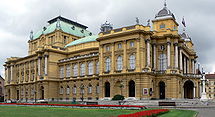- Croatian National Theatre in Zagreb
-
For other uses, see Croatian National Theatre.
Croatian National Theatre in Zagreb 
Croatian National Theatre building in ZagrebAddress 15 Marshal Tito Square City Zagreb Country Croatia Architect Fellner & Helmer Owned by Republic of Croatia (51 %)
City of Zagreb (49 %)Capacity 785 (est.) Type National, opera house Opened 14 October 1895 Rebuilt Late 1960s www.hnk.hr The Croatian National Theatre in Zagreb (Croatian: Hrvatsko narodno kazalište u Zagrebu), commonly referred to as HNK Zagreb, is a theatre located in Zagreb, owned and operated by the Ministry of Culture. The theatre evolved out of the first city theatre built in 1836 housed in the present-day Old City Hall. The theatre was first established as the Croatian National Theatre in 1860, and in 1861 it gained government support putting it on par with many other European national theatres. In 1870 an opera company was added to the theatre and in 1895 it moved to the new purpose-built building on Marshal Tito Square in Zagreb's Lower Town, where it is based today.
Austro-Hungarian emperor Franz Joseph I was at the unveiling of this new building. The building itself was the project of famed Viennese architects Ferdinand Fellner and Herman Helmer, whose firm had built several theatres in Vienna. Celebrations marking the 100th anniversary of the building were held on October 14, 1995.
At the entrance of the theatre is located the famed wall fountain The Source of Life, designed by Croatian artist and sculptor Ivan Meštrović in 1905.
Many of Croatia's finest artist have worked at the Theatre. Ivan Zajc was the Theatre's first conductor. Jakov Gotovac was the Theatre's opera conductor from 1923 to 1958. The famous Croatian theatre director Branko Gavella began his career here, as did the first Croatian prima ballerina Mia Čorak Slavenska.
The theatre has also seen many international artists including Franz Liszt, Sarah Bernhardt, Franz Lehár, Richard Strauss, Gerard Philipe, Vivien Leigh, Laurence Olivier, Jean-Louis Barrault, Peter Brook, Mario del Monaco, José Carreras.
There are also Croatian National Theatres in Split, Rijeka, Osijek, Varaždin and Zadar.
See also
External links
- Croatian National Theatre in Zagreb
- Croatian National Theatre, Split
- Croatian National Theatre, Rijeka
- Croatian National Theatre, Osijek
- Croatian National Theatre, Zadar
- Croatian National Theatre, Varaždin
Zagreb History History of Zagreb · Gradec · Kaptol · Krvavi most · 1880 earthquake · 1995 rocket attacks · Zagreb crisis · MayorsDistricts Brezovica · Črnomerec · Donja Dubrava · Donji grad · Gornja Dubrava · Gornji grad-Medveščak · Maksimir · Novi Zagreb-istok · Novi Zagreb-zapad · Peščenica-Žitnjak · Podsljeme · Podsused-Vrapče · Sesvete · Stenjevec · Trešnjevka-jug · Trešnjevka-sjever · TrnjeBuildings and
landmarks1 Ilica Street · Ban Jelačić Square · Banski dvori · British Square · Cibona Tower · Dolac Market · Grič Cannon · Ilica Street · Jarun · Kallina House · Lotrščak Tower · Maksimir Park · Marshal Tito Square · Medvedgrad · Meštrović Pavilion · Mirogoj Cemetery · Nikola Šubić Zrinski Square · Nine Views · Old City Hall · St. Mark's Square · Tkalčićeva Street · ZagrepčankaChurches Culture Croatian National Theatre in Zagreb · Gavella Drama Theatre · Vatroslav Lisinski Concert Hall · National and University LibraryGalleries and
museumsArchaeological Museum · Art Pavilion · Croatian Museum of Naïve Art · Glyptotheque · Klovićevi dvori · Mimara Museum · Modern Gallery · Museum of Broken Relationships · Museum of Contemporary Art · Strossmayer Gallery · Technical Museum · Zagreb City MuseumEducation Croatian Academy of Sciences and Arts · University of Zagreb (Academies: Dramatic Art · Fine Arts · Music · Faculties: Economics and Business · Electrical Engineering and Computing · Geodesy · Humanities and Social Sciences · Medicine · Teacher Education)Sports venues Transport Festivals Categories:- Buildings and structures in Zagreb
- Fellner & Helmer buildings
- Donji grad
- National theatres
- 1860 establishments
- Buildings and structures completed in 1895
- Theatres in Zagreb
Wikimedia Foundation. 2010.

